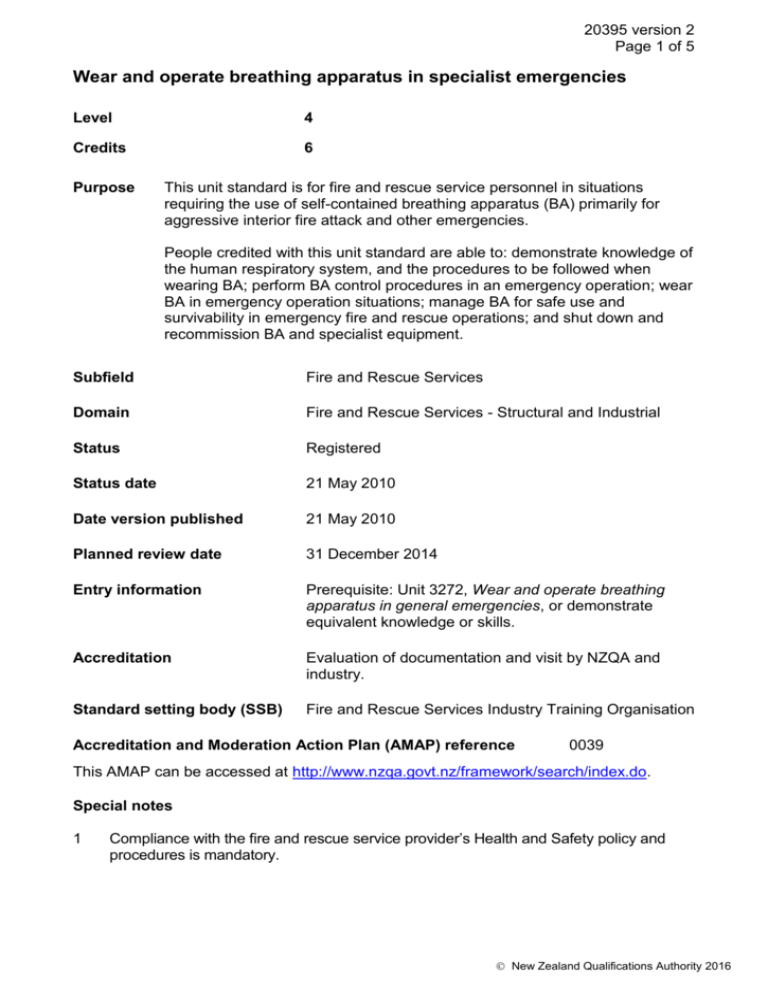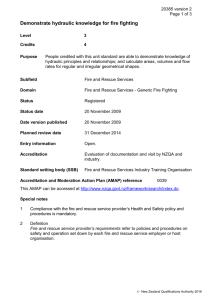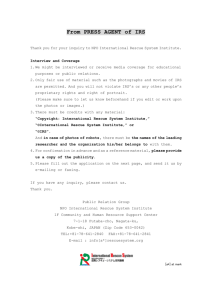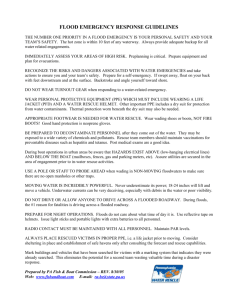20395 Wear and operate breathing apparatus in specialist
advertisement

20395 version 2 Page 1 of 5 Wear and operate breathing apparatus in specialist emergencies Level 4 Credits 6 Purpose This unit standard is for fire and rescue service personnel in situations requiring the use of self-contained breathing apparatus (BA) primarily for aggressive interior fire attack and other emergencies. People credited with this unit standard are able to: demonstrate knowledge of the human respiratory system, and the procedures to be followed when wearing BA; perform BA control procedures in an emergency operation; wear BA in emergency operation situations; manage BA for safe use and survivability in emergency fire and rescue operations; and shut down and recommission BA and specialist equipment. Subfield Fire and Rescue Services Domain Fire and Rescue Services - Structural and Industrial Status Registered Status date 21 May 2010 Date version published 21 May 2010 Planned review date 31 December 2014 Entry information Prerequisite: Unit 3272, Wear and operate breathing apparatus in general emergencies, or demonstrate equivalent knowledge or skills. Accreditation Evaluation of documentation and visit by NZQA and industry. Standard setting body (SSB) Fire and Rescue Services Industry Training Organisation Accreditation and Moderation Action Plan (AMAP) reference 0039 This AMAP can be accessed at http://www.nzqa.govt.nz/framework/search/index.do. Special notes 1 Compliance with the fire and rescue service provider’s Health and Safety policy and procedures is mandatory. New Zealand Qualifications Authority 2016 20395 version 2 Page 2 of 5 2 Legislation and guidelines relevant to this unit standard include the Health and Safety in Employment Act 1992, and Occupational Safety and Health Guidelines. 3 Assessment against this unit standard may take place under real or practical simulated situations. 4 Confined space is as defined in AS/NZ 2865:2009 Confined spaces, and any activities within a confined space must conform to this standard. 5 The maintenance and use of BA must comply with AS/NZS 1715:2009 Selection, use and maintenance of respiratory protective equipment. 6 Definitions Fire and rescue service provider’s requirements refer to policies and procedures on safety and operation set down by each fire and rescue service employer or host organisation. Gas suits refer to fully-encapsulating Level 4 gas suits that provide head to toe protection for the wearer and the BA against liquids, particulates, vapours, and gases. The suit is fully liquid and gas tight. Specialist equipment refers to air lines, gas suits, splash suits, and BA main guide lines. Splash suits refer to one-piece non-encapsulating Level 3 chemical splash suits which provide head to toe protection for the wearer against liquids and particulates. The suit is liquid tight but not fully gas tight. Elements and performance criteria Element 1 Demonstrate knowledge of the human respiratory system, and the procedures to be followed when wearing BA. Performance criteria 1.1 The physiology of breathing and associated conditions of the human body are described and explained in accordance with the fire and rescue service provider’s requirements. Range 1.2 The responsibilities associated with control officers for BA are listed and described in accordance with the fire and rescue service provider’s requirements. Range 1.3 respiration, asphyxiation, heat, stress, stroke, exhaustion. entry control officer (ECO), breathing apparatus control officer (BACO). Hazards associated with the wearing of BA are described in accordance with the fire and rescue service provider’s requirements. Range extreme cold, under water, set failure. New Zealand Qualifications Authority 2016 20395 version 2 Page 3 of 5 1.4 Procedures associated with the wearing of BA are explained in accordance with the fire and rescue service provider’s requirements. Range 1.5 guidelines, testing, safety, set failure, search, emergency evacuation. Standard tests for self-contained breathing apparatus (SCBA) and specialist equipment used in specialist BA operations are explained in accordance with AS/NZS 1715:2009 and the fire and rescue service provider’s requirements. Range type, frequency. Element 2 Perform BA control procedures in an emergency operation. Performance criteria 2.1 Rapid deployment boards where supplied are managed in accordance with the fire and rescue service provider’s requirements. 2.2 Stage 1 control (ECO) is managed in accordance with the fire and rescue service provider’s requirements. Range 2.3 entry control board, tallies, relief crews, rescue teams, emergency procedures, communications, resource requirements, main line use, branch line use. Stage 2 control (BACO) is explained in accordance with the fire and rescue service provider’s requirements. Range relief crews, rescue teams, emergency procedures, communications, resource requirements. Element 3 Wear BA in emergency operation situations. Performance criteria 3.1 Personal protective clothing is selected and worn in extreme temperature emergency situations in accordance with the fire and rescue service provider’s requirements. Range 3.2 300 degrees Celsius, minus 20 degrees Celsius. Personal protective equipment is selected and worn for hazardous substance emergencies in accordance with the fire and rescue service provider’s requirements. Range splash suits, gas suits, air lines (where supplied). New Zealand Qualifications Authority 2016 20395 version 2 Page 4 of 5 3.3 BA main guidelines are established and used in accordance with the fire and rescue service provider’s requirements. 3.4 Search procedures are carried out whilst wearing BA in accordance with the fire and rescue service provider’s requirements. Element 4 Manage BA for safe use and survivability in emergency fire and rescue operations. Performance criteria 4.1 The environment is continually assessed in accordance with the fire and rescue service provider’s requirements. Range 4.2 Air supply is managed in accordance with the nature of the incident and the fire and rescue service provider’s requirements. Range 4.3 incident development, structural hazards, general hazards. self, crew, task. Entrapment procedures are demonstrated in accordance with the fire and rescue service provider’s requirements. Range self, crew. Element 5 Shut down and recommission BA and specialist equipment. Performance criteria 5.1 BA is shut down in accordance with the fire and rescue service provider’s requirements. 5.2 Information is reported and relayed to the ECO in accordance with the fire and rescue service provider’s requirements. 5.3 BA and specialist equipment is recommissioned in accordance with the fire and rescue service provider’s requirements. 5.4 Documentation is completed in accordance with the fire and rescue service provider’s requirements. Please note Providers must be accredited by NZQA, or an inter-institutional body with delegated authority for quality assurance, before they can report credits from assessment against unit standards or deliver courses of study leading to that assessment. New Zealand Qualifications Authority 2016 20395 version 2 Page 5 of 5 Industry Training Organisations must be accredited by NZQA before they can register credits from assessment against unit standards. Accredited providers and Industry Training Organisations assessing against unit standards must engage with the moderation system that applies to those standards. Accreditation requirements and an outline of the moderation system that applies to this standard are outlined in the Accreditation and Moderation Action Plan (AMAP). The AMAP also includes useful information about special requirements for organisations wishing to develop education and training programmes, such as minimum qualifications for tutors and assessors, and special resource requirements. Comments on this unit standard Please contact the Fire and Rescue Services Industry Training Organisation info@frsito.org.nz if you wish to suggest changes to the content of this unit standard. New Zealand Qualifications Authority 2016





